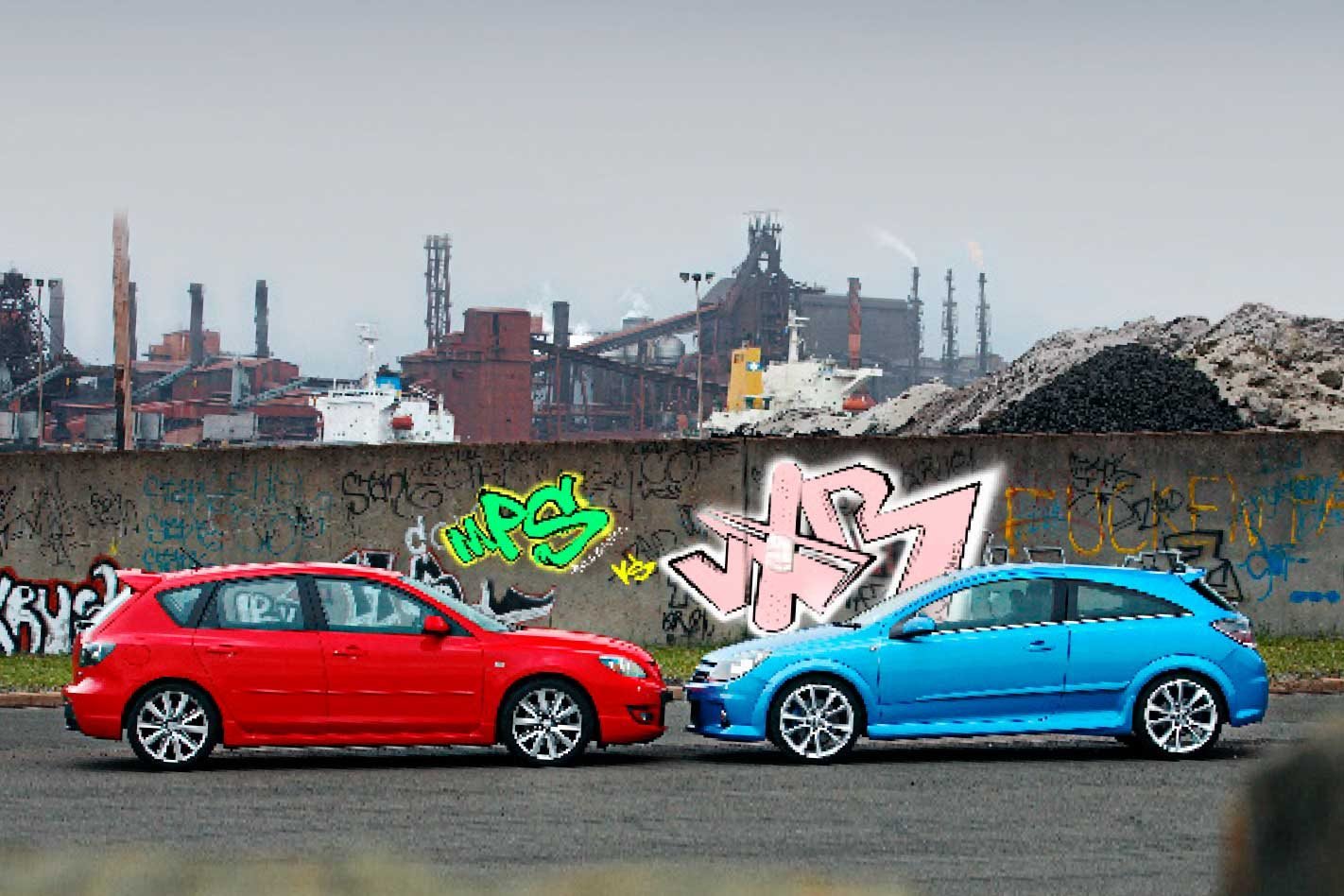There’s an angry man hidden in the HSV VXR’s dashboard and he’s trying to rip my arms off.
This review was originally published in MOTOR’s April 2007 issue
Flatten the accelerator and he erupts, his tattooed arms tugging and sawing at the Astra’s chunky wheel as he attempts to spit the car sideways.
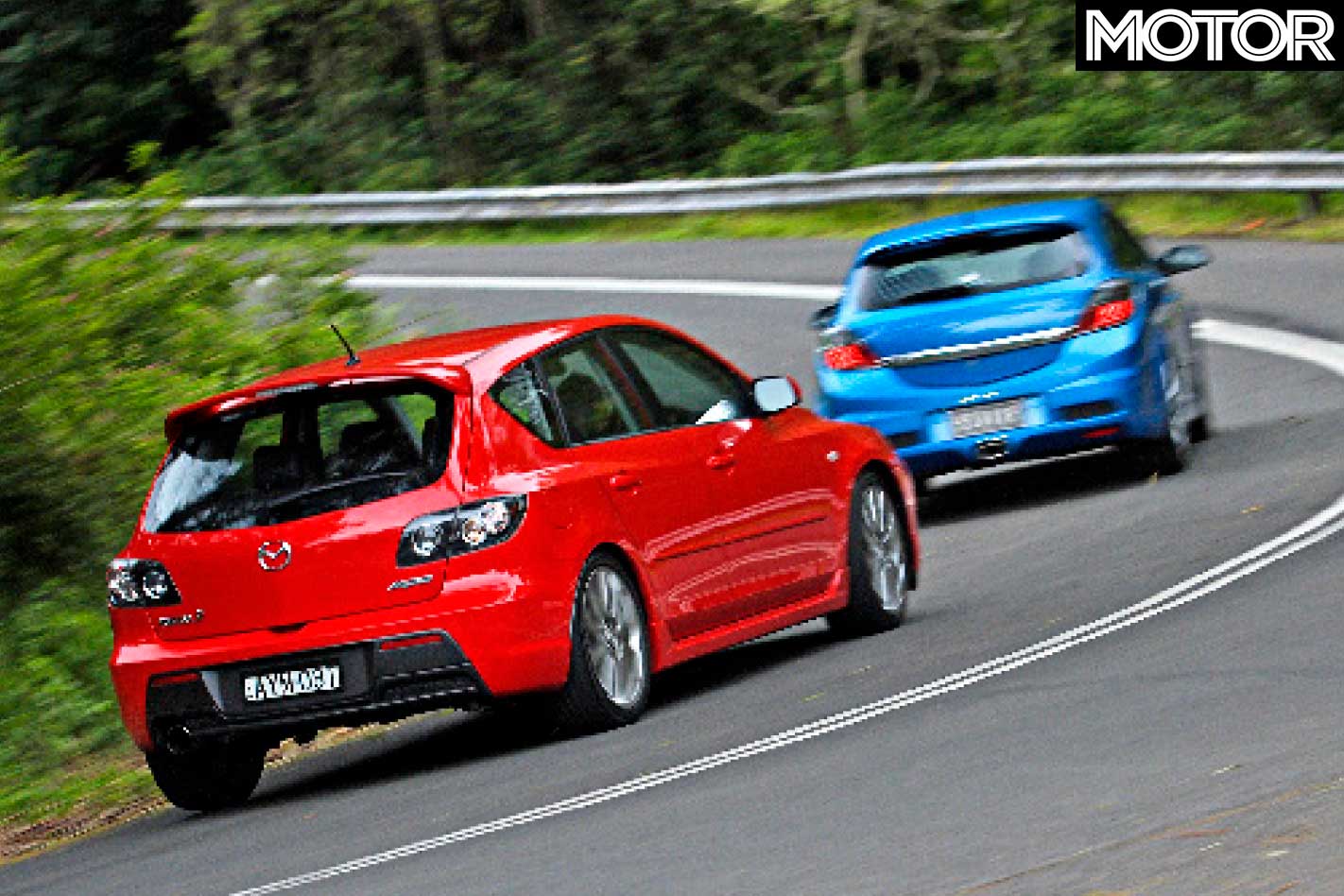
It’s a violent, engaging, exhilarating introduction to Holden’s new hot-hatch contender, the 2.0-litre turbo-charged Astra VXR, yet if the newcomer is to succeed it not only has to tame the beast lurking in the shadows of its front-paw set-up, but it must also topple the current hot-hatch king; the Mazda 3 MPS.
And that won’t be easy. Back in November of last year we raved about the Mazda and its huge dollops of useable shove that shamed performance cars several leagues above. Its neutral balance and composure inspired confidence in medium-to-long flowing corners, while its understated five-door looks and Q-car appeal made it the ideal sportscar predator.
But now it’s the VXR’s turn to create a scene, and with that curvaceous, chop-shopped three-door profile it’s off to good start. Based on the stock Astra Coupe, the VXR finds a perfect niche between the fussy design of the Focus XR5 on one side and the lacklustre lines of the Golf GTI and Mazda 3 MPS on the other.
Squat and menacing on standard 19-inch rims, the high and narrow side-windows are coupe sleek, while the blistered arches and jutting chin spoiler inject a masculine, aggressive edge to proceedings.
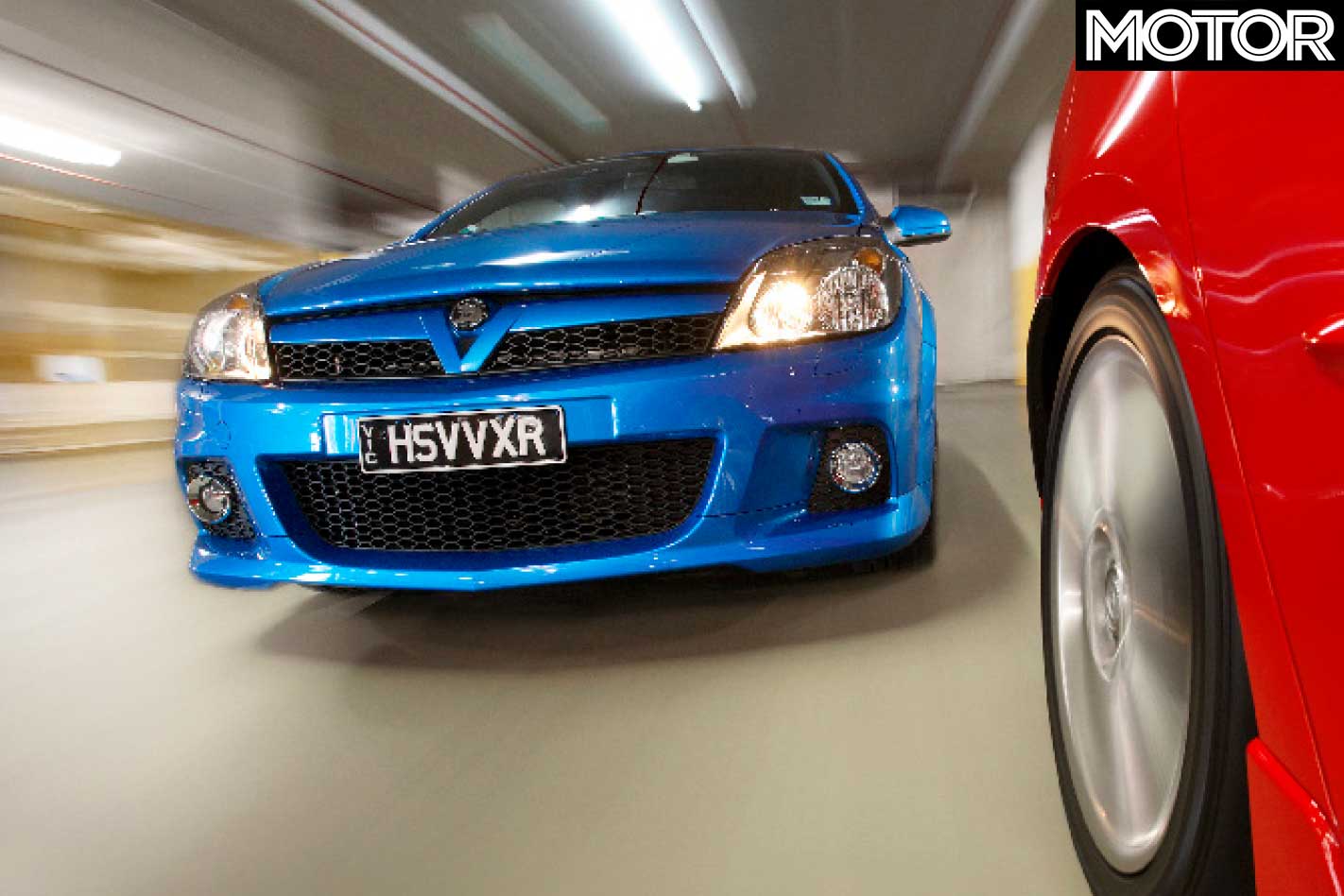
Pedants could accuse the trapezoidal exhaust pipe and chrome boot strip of being too finicky, yet next to the modest lines and subtle bulges of the Mazda, the Astra is sexier than a digitally-remastered Lara Croft.
Maybe it’s the door count and flat red paint, but after the primal stirrings of the VXR, the Mazda causes little more than a twitch – there’s certainly more bulge in the MPS’s bonnet than there will be in your pants.
But that’s not to say it doesn’t appeal. The transformation to MPS spec may be subtle, but the designers have executed it with care, neatly grafting the deep front and rear air-dams, cute roof-spoiler and gaping exhaust to the standard bodywork.
At 18 inches, the smoked chrome multi-spoke alloys are a notch smaller than the Astra’s, but they still fill the arches nicely. You just get the impression Mazda is appealing to those in the know and not the phone-snapping teenagers.
Step inside and the roles instantly reverse, the Holden becoming the drab, emotionless bureaucrat while the Mazda slips off its strides and goes skinny-dipping. Both cars have Recaro tattooed on their front seats but that’s where the similarities end.
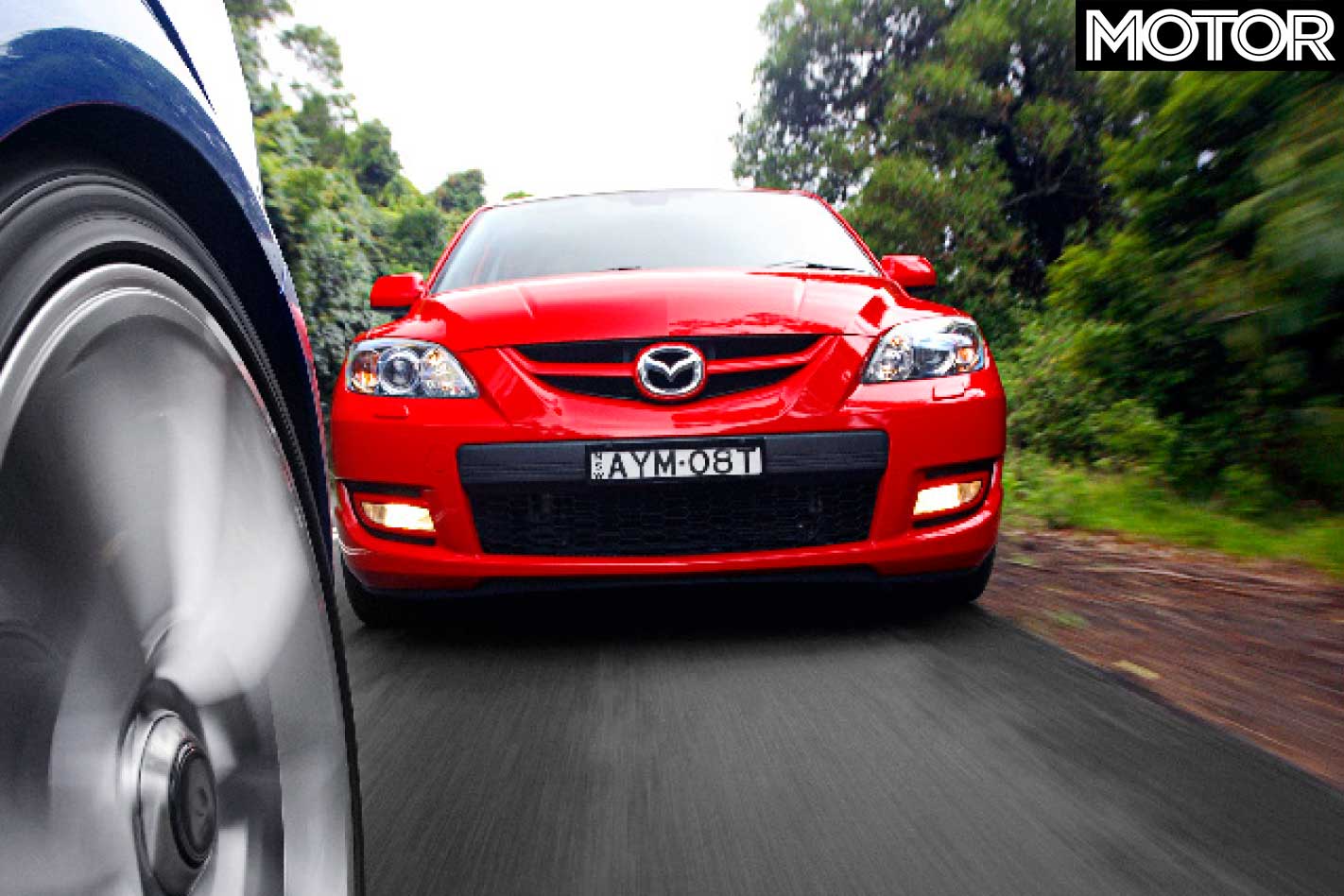
Despite the flecks of VXR livery and a chunky, small-diameter steering wheel, the Astra is the poster child of straight-laced utilitarian functionality. Square buttons located with the haphazardness of kids laying out Lego, hard grey plastics and a general feeling that there’s no salsa on the VXR’s burrito sums up the view from the Astra’s driving seat.
Step from the VXR into the MPS and it’s a revelation. A well laid-out dashboard hosts a series of silver-flecked instruments and red-ribbed dials, while the part-leather seats and aluminium pedals of the optional Sports Pack add prestige to the standard Mazda 3 cabin.
But I have my reservations. Like the loudest guy at a party, the MPS’s cabin makes the mistake of attracting all the attention and then failing to back it up with any substance. The plastics are hard and brittle, the steering wheel lacks the sporting contours of the Astra’s rudder, and staring down the barrel of the cylindrical speedo pods distracts from the job of driving. The speedo indicators are some 10km/h off to the minus, as well.
But we’re not here to pontificate over the minutia of speedo dials and hard plastics; we’re here to decide which of these hot-hatch goliaths deserves your hard-earned when it comes to signing the cheque.
Blatting along the sweeping coastal roads north of Sydney, the VXR spits and froths away from every set of traffic lights. The angry red-neck is still there, tugging away at the steering wheel, but with familiarity he’s more a lively drinking buddy than an unbearable bastard.
The first thing you notice is the lack of turbo lag. Boost builds early, with the full 320Nm glob of torque available at 2400rpm. The result is a linear, unrelenting surge when the adrenalin flows, but also a surprisingly crisp sixth-gear pick-up when cruising. Spearing triple figures in 6.9 seconds and the quarter in 15.2, the VXR is quick by anyone’s standards, but it’s certainly not the undriveable savage we were led to believe.
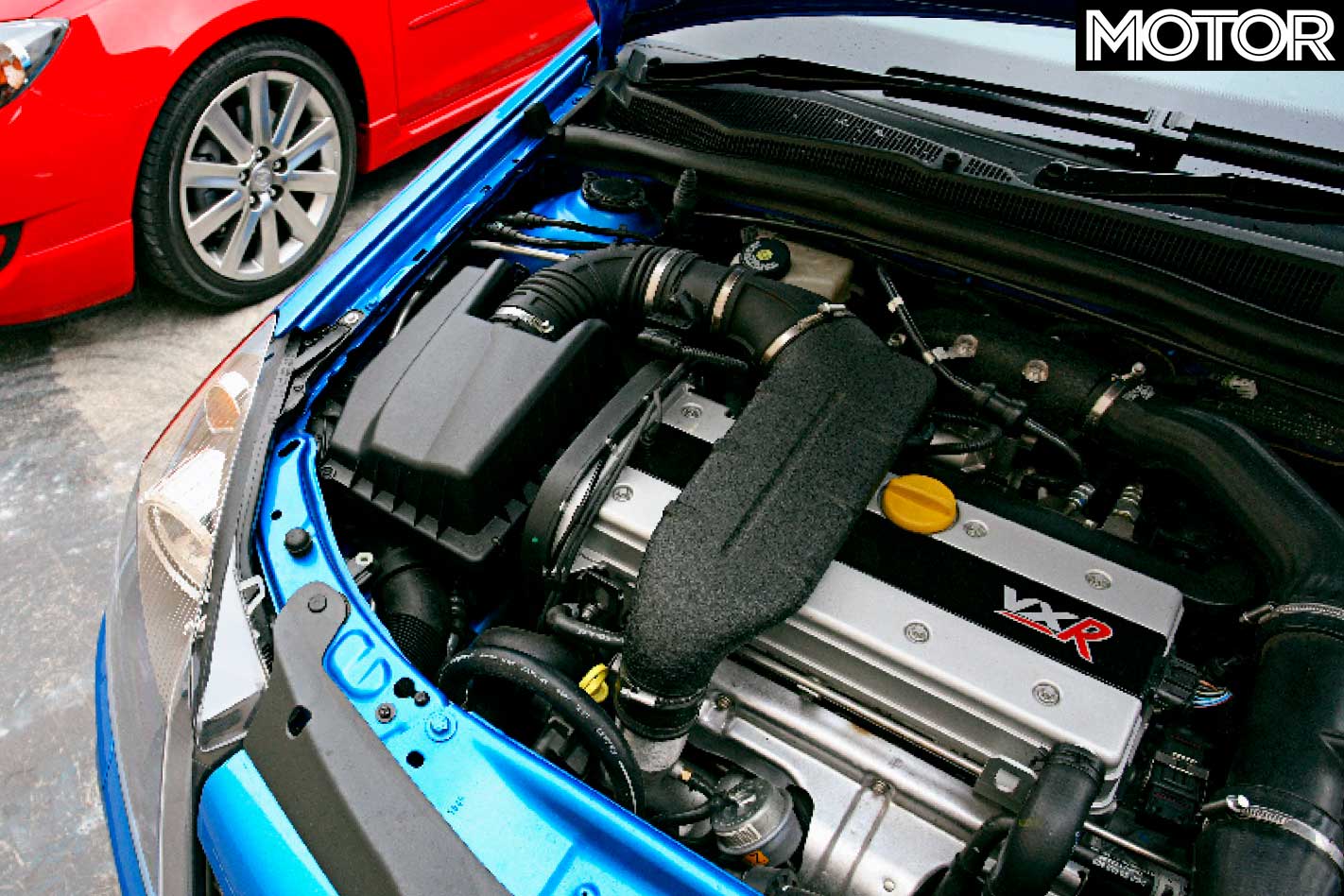
Then you get to a twisty section and, with sport button engaged (this sharpens the throttle response and loosens the reins of the traction control), the VXR sets off like its balls are on fire. Galloping hard towards the first apex, it’s down through the slick six-speed ’box, clutch down to third, down to second, blip of the throttle with the heel, hard on the easily-moderated brakes with the toe, turn in, front-end bites and settles, feed in the power, running wide to miss the ute parked on the inside verge, ease off, the back-end breaks and slides wide in a predictable arc bringing the front in tight, feed out the lock, full power, revs flare beyond 4000rpm, the engine adopts a harsh induction bark and the VXR picks up another scent, scampering hard towards the next apex.
Six klicks and a rhythmic stretch of liquorice lace behind us, it’s time to take a breather. Clambering from the Astra’s deeply bolstered seats, it’s only now that I realise my buttocks are still clenched and my mouth’s as dry as a South Australian dam.
The reality is this: the VXR’s trump card is its drama. It’s not civilised, it’s not going to waft you along on a fluffy bed of roses, it’s going to toss you like a salad and stick its toe so far up your arse it’ll be able to drop-kick your tonsils.
Next the Mazda, and as their publicity men have seen fit to pin a devil’s tail on the 3MPS’s sporty rump, I tug gingerly on the demon’s door-handle, conscious that I might just be opening the gates of hell. I needn’t have worried. Firing up the turbo-charged 2.3-litre soul reveals a benevolent tone, more akin to God grumbling than Satan belching. Filtering into the stop-start city traffic the MPS feels civilised and well mannered, picking up smoothly and chugging merrily on part throttle until the traffic clears and the pedal finally hits the deck.

Against the clock the Mazda is the quicker of the two (6.8 seconds to the tonne, 14.8 on the quarter), but, for the electronic interference in the Mazda, it doesn’t always feel it. You see, to ensure the MPS’s doesn’t cook its tyres before the first full-moon, Mazda engineers have installed Switchable Dynamic Stability control and torque sensing limited slip-diff – the latter absent on the Astra – which together work to harness power in the first two cogs. The result is a far more linear and controlled deployment of power in the Mazda than in the VXR.
Not that it’s perfect. Catch the MPS off the boil and the lag from the low-pressure turbo is more noticeable than in the Astra, requiring a greater level of concentration if you’re to make that blink-and-you-miss-it gap in traffic. Scanning the stats of both cars, it’s easy to see why.
With 380Nm at 3000rpm, the Mazda may have more torque than the 320Nm VXR, but as it arrives 600rpm further up the rev range it allows the Astra to throw the first punch. Ultimately, though, it’s the Mazda that hits hardest.
But as the creative minds at Pirelli keep telling us; Power Is Nothing Without Control, so the first time you throw the 3MPS into a corner it’s a relief to find it remains calm and balanced, allowing minute throttle and wheel inputs to keep things honest. It lacks the seat-of-your-pants sensation of the Astra, but the added adjustability is more than welcomed on unfamiliar territory.
It’d be easy to put the difference down to personality traits, but the reality is the Mazda has a more exotic rear-suspension set-up than the Vauxhall. While the VXR relies on a good old-fashioned torsion beam rear axle, resulting in a fidgty, boisterous ride, the MPS carries its arse on a trick multi-link rear set-up, allowing it to gobble down bumps and road scars will little more than a belch. But don’t think that makes the VXR any less of weapon. It’s just one that could go off in your hand at any time.
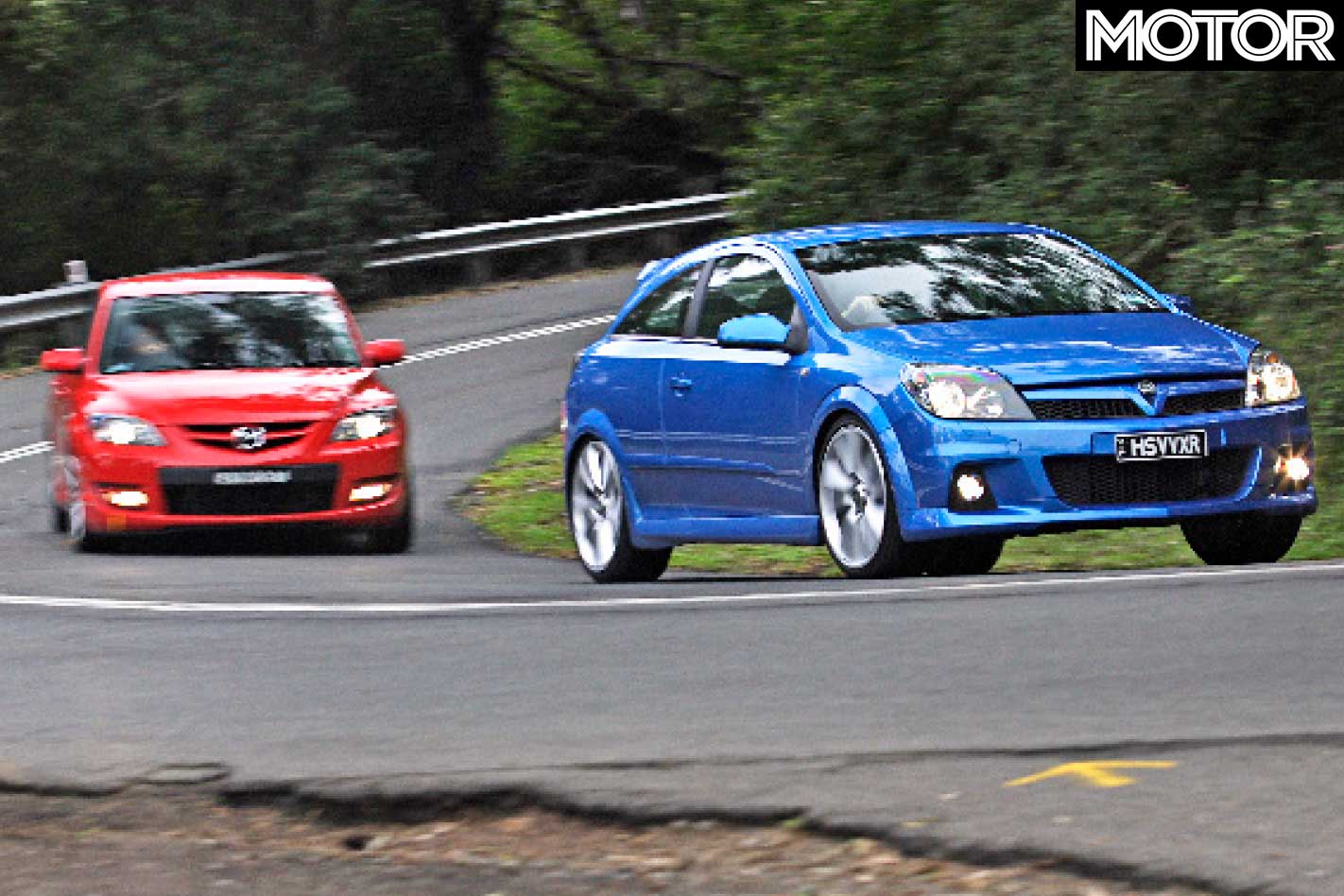
Ultimately, the 3 is more compliant, more benign at the outer reaches of the fanging envelope than the more nervous VXR. Its typically delicate chassis balance – a trait of late-gen Mazdas – imparts plenty of turn-in bite through steering that may be muffled, but also more chatty than the VXR’s.
The 3 also backs up its go with well-modulated, fade-free whoa, thanks to beefier sliding caliper hardware up front. Just as well, because it can take a terrifying turn of pace right up to the apex – and beyond, if you’re not ready for it. On my usual test loop I find I’m always a gear higher; there’s little point holding a cog past 6700. The torque reduction function on second works brilliantly – there’s just not enough legs in that gear to exploit it fully.
So which should you buy? If you’re crunching the numbers, the 3 will leave you some $3000 better off ($39,990 plays $42,990), but gives you more herbs (190kW plays 176kw), more doors (if that’s important to you) and better handling across the gamut of terrain you’re likely to encounter. The HSV gives you sex-pot looks, a bit of exclusivity (your new hottie is unlikely to be mistaken for your mum’s shopping hack) and a lot of immediate, visceral pleasure.
Tough call, but the more measured ride and extra oomph tips our hand towards the devil’s tail. This time.
Fast Facts

| u00a0 | Mazda 3 MPS | HSV Astra VXR |
| Body | 5-door, 5-seat hatch | 3-door, 5-seat sedan |
| Drive | front-wheel | |
| Engine | 2260cc inline-4, DOHC, 16v, turbo | 1998ccu00a0inline-4, DOHC, 16v, turbo |
| Bore x Stroke | 87.5 x 94.0mm | 86.0 x 86.0mm |
| Compression | 9.5:1 | 8.8:1 |
| Power | 190kW @ 5500rpm | 177kW @ 5600rpm |
| Torque | 380Nm @ 3000rpm | 320Nm @ 2400rpm |
| Power/Weight | 135kW/tonne | 127kW/tonne |
| Transmission | 6-speed manual | |
| Ratios | 3.54/2.24/1.54/1.17/1.09/0.86 | 3.82/2.16/1.48/1.07/0.88/0.74u00a0 |
| Final Drive | 3.94 (1st-4th) 3.36 (5th-6th) | 3.94u00a0 |
| Weight | 1403kg | 1393kg |
| 0-100km/h | 6.8sec | 6.9sec |
| 0-400m | 14.8sec | |
| Suspension (f) | struts with coils and double absorbers | u00a0struts, coils, anti-roll bars,u00a0Lotus springs and dampers |
| Suspension (r) | independent multi-link with low profile springs and cylindrical shock absorbers | u00a0torsion beam,u00a0Lotus springs and dampers |
| L/W/h | 4430/1765/1465mm | 4290/1753/1420mmu00a0 |
| Wheelbase | 2640mm | 2614mmu00a0 |
| Tracks | 1535/1525mm (f/r) | u00a01480/1477mm |
| Steering | power rack and pinion | |
| Turning circle | 11.0m | u00a010.85m |
| Brakes (f) | 320mm ventilated discs, twin-piston calipers | u00a0321mm ventilated rotors, sliding calipers |
| Brakes (r) | 300mm ventilated discs, twin-piston calipers | u00a0278mm solid discs sliding calipers |
| Tyre Sizes | 215/45ZR18 (f/r) | u00a0235/35ZR19 (f/r) |
| Tyres | Bridgestone Potenza | Continental SportContact 2u00a0 |
| Price | $39,990 | $42,990u00a0 |
| Pros | Composed handling, excellent brakes, good value and practical | Old school hot-hatch charm, lively steering, sexy looks, feels fastu00a0 |
| Cons | Turbo-lag, plain looks, shopping hack image | u00a0Jittery over the rough stuff, dull interior, poorly-labelled speedo |
| Rating | 4 out of 5 stars | 3.5 ouf ot 5 stars |

